Page Table of Contents
About the Author
Hot Topics
Updated on Dec 23, 2025
If you cannot distinguish between system cloning and system migration, you only need to go by their names. A system clone means creating an exact copy of the existing system disk with all partitions on it. System migration generally transfers system data or information from one system/disk/drive to another. Follow through this article, and you will learn about system cloning vs system migration and their differences in detail.
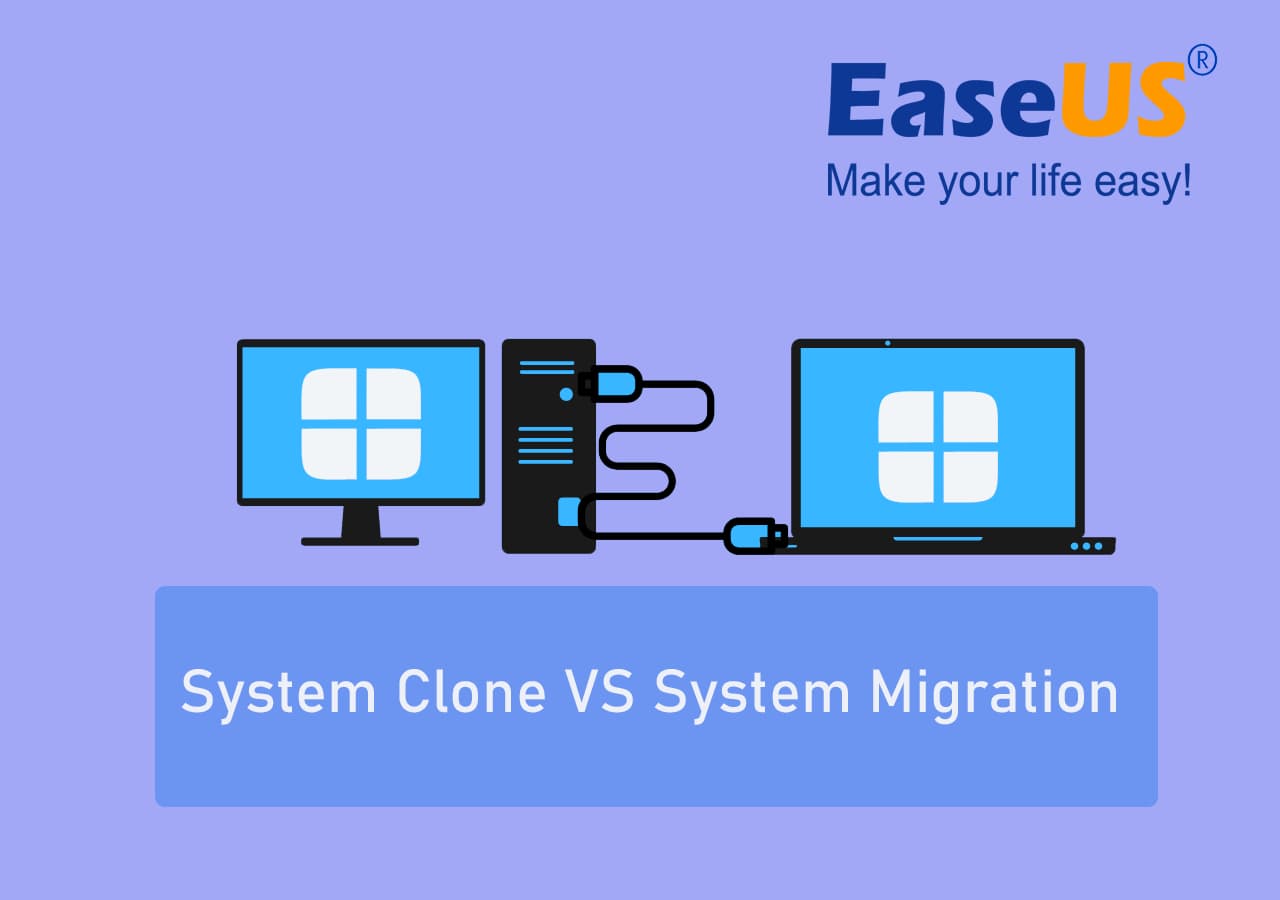
The difference between these depends on the real-time purpose of the operations we use. The procedure you should opt for depends on your targets, like whether you want an exact copy of the existing system or to move files from one system to another, as discussed above.
What Is System Clone and System Migration
Now you know what cloning and migration mean, let us get to the actual definitions and use cases in the subsequent sections.
What Is System Clone
System cloning in computers or PCs refers to creating an exact copy of the existing system for backup or Data transfer. Or remake your Computer's Operating system and all its settings, data, and information to get identical systems. Sometimes, system clone is also known as OS disk clone.
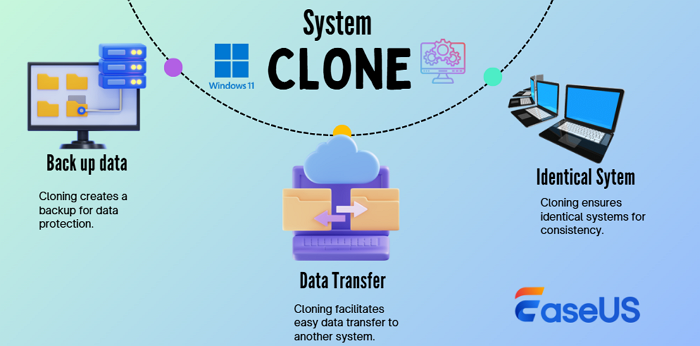
What Is System Migration
System Migration in computers transfers the data, settings, or user environment between two computers. We often see this when people buy a new PC rather than redo everything. They migrate all the requirements to the new one with the help of hard drives.
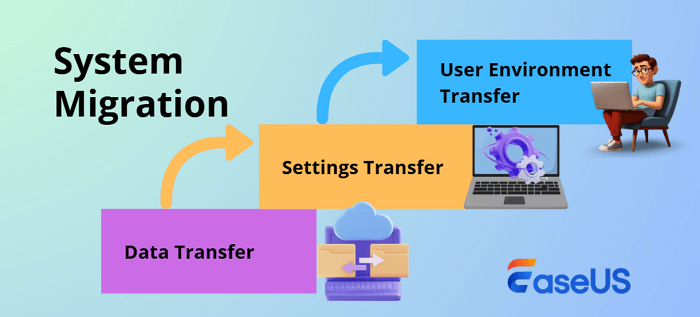
System Clone VS System Migration: What's The Differences
You already know the main difference, definition, and purposes between system migration and system cloning (disk cloning). Please look at the table below to note the significant differences between them.
| Comparison | System Clone | System Migration |
|---|---|---|
| 🧩Process | Makes an exact copy of the system, including data, applications, and system settings. | Transfers the required or desired data to another PC. |
| 🚩Goal | The final output is a bit-by-bit copy of the original one. | The new system contains only the transferred data and applications. |
| 🔖Scenarios | Used in the cases of backup and similar system configurations. | Used when upgrading to a new version or moving a specific system from one OS to another. |
| 🧰Tools | The process is carried out using bootable CDs or USBs with OS or disk cloning software. | This can be done using OS migration software, manually transferring using cables, or with the help of cloud services. |
Best Software for System Clone and System Migration
In the previous sections, we discussed the differences for system cloning and migration. These operations may sound simple if you go by their names, but the whole thing depends on the tool you are using.
If you wonder, "Is there a tool that enables people to execute system clone and system migration operations?". Then, EaseUS Partition Master Professional is your solution.
What Can EaseUS Partition Master Help You with OS Cloning and Migration?
Here is a checklist of what EaseUS Partition Master can do for you in executing OS cloning and system migration.
System Clone:
- 🚩Clone the entire OS disk, transfer everything to the new disk.
- 🚩Duplicate partitions or disks without any data loss.
System Migration:
- 🚩Seamlessly move Windows to another drive.
- 🚩Transfer data and applications onto the new disk without malfunctions.
- 🚩No data loss.
Enjoy Bonus Feature After OS Cloning or Migration
All the processes are safe and secure with no complications and can be completed in a few simple clicks. Alongside system cloning and system migration, you can also enjoy the following listed features offered by EaseUS Partition Master:
- Managing partitions on hard drives and SSDs.
- Check and benchmark HDD and SSD.
- Monitor disk health state.
- Reallocate disk space, etc.
Let us move to the next parts to learn the steps on how to clone and migrate the systems using EaseUS Partition Master. Download the software tool and follow this guide to complete these complex operations in simple steps.
Clone System Checklist & Step-Guide
Before you start, here's an OS cloning checklist for you to view and follow to get everything ready:
- ✔️Prepare a new disk: an equal or bigger storage space than the OS disk.
- ✔️Install and initialize the disk: initialize the new HDD or SSD to the same type of the OS disk - MBR/MBR, GPT/GPT.
- ✔️End task of all running programs: exit or close all running programs, stop transferring or using any files.
- ✔️Back up vital data: create a backup of important data on the OS disk to another drive if possible.
- ✔️Don't interrupt the operation: once you start the cloning process, don't pause or halt the operation.
- ✔️Install OS or disk cloning software: get a reliable OS cloning or disk cloning software installed on your PC.
Step-Tutorial: How to Clone OS Disk to a New Disk
Step 1. Launch EaseUS Partition Master, go to the Disk Clone tab, select "Clone OS Disk" and click "Next".
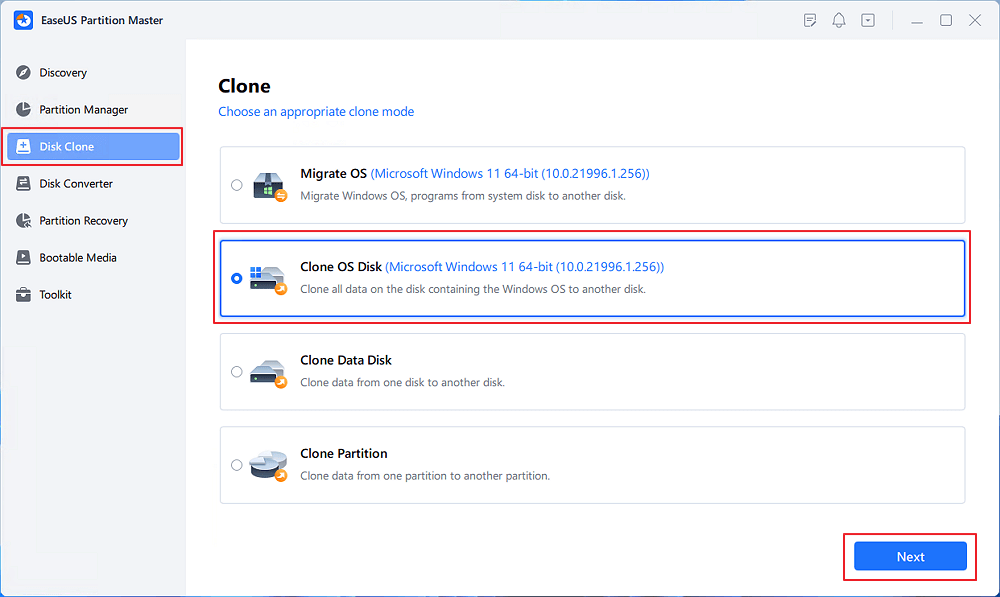
Step 2. Select the target new drive where you want to clone the OS to, and click "Next".
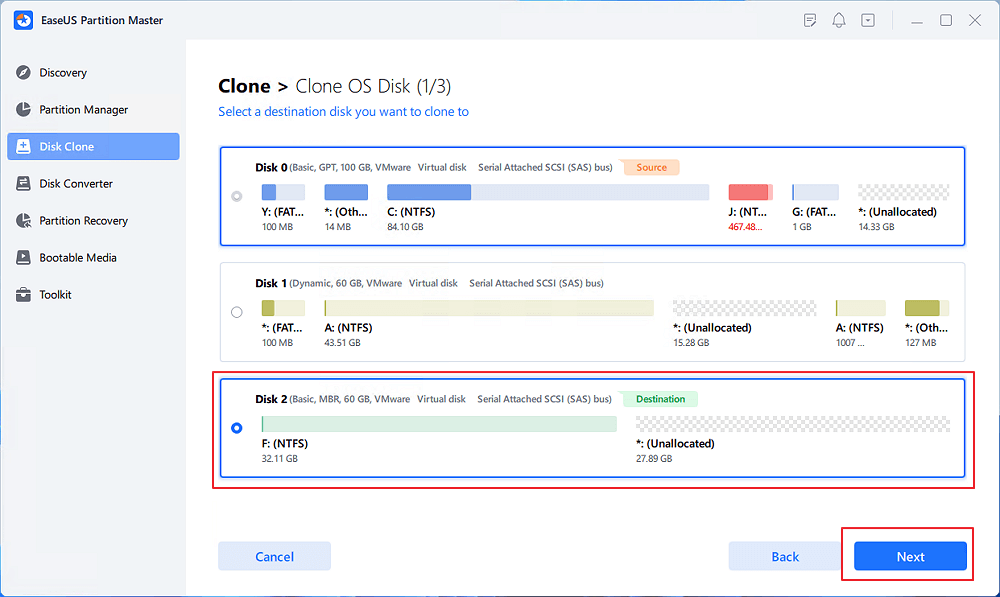
Click "Yes" to confirm that you want to continue the OS disk cloning process.
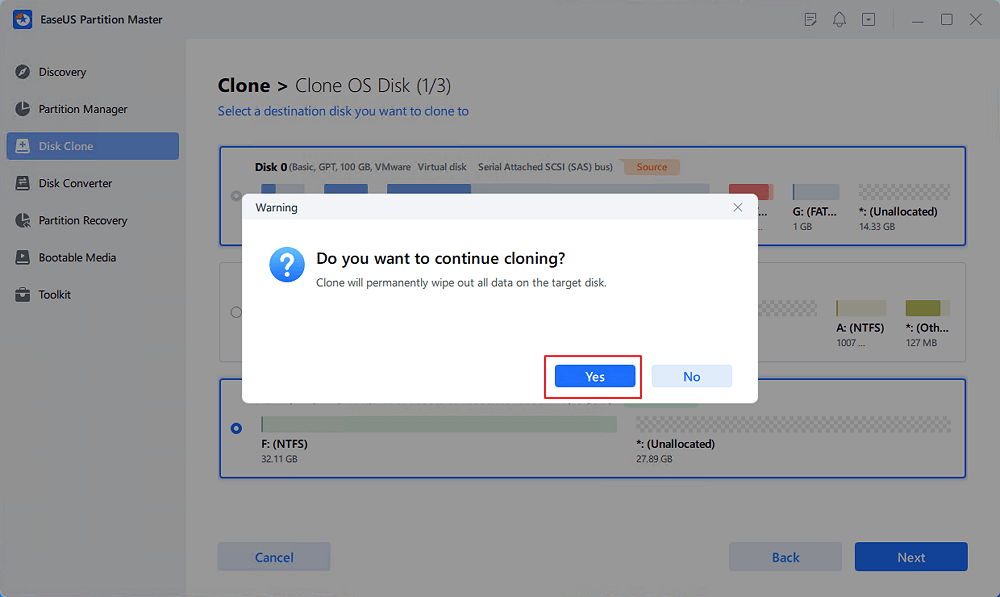
Step 3. View the disk layout, and click "Start" to begin the OS cloning process.
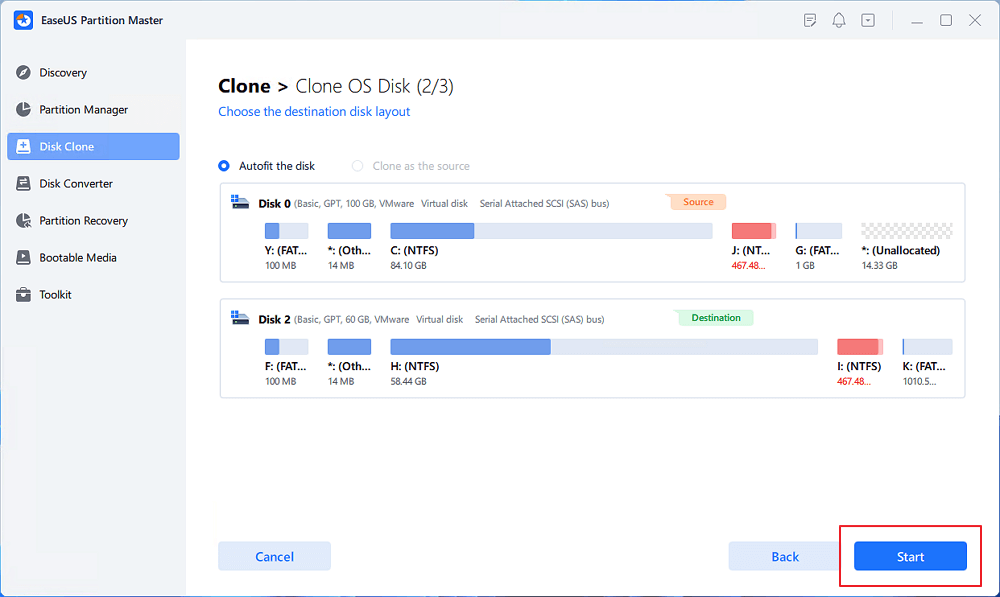
Step 4. When the process completes, you'll see a confirming message, asking "if you want to start up computer from the clone target disk".
- Reboot Now means to reboot your PC and configure the computer to boot OS from the new disk immediately.
- Done means you want to make the changes later.
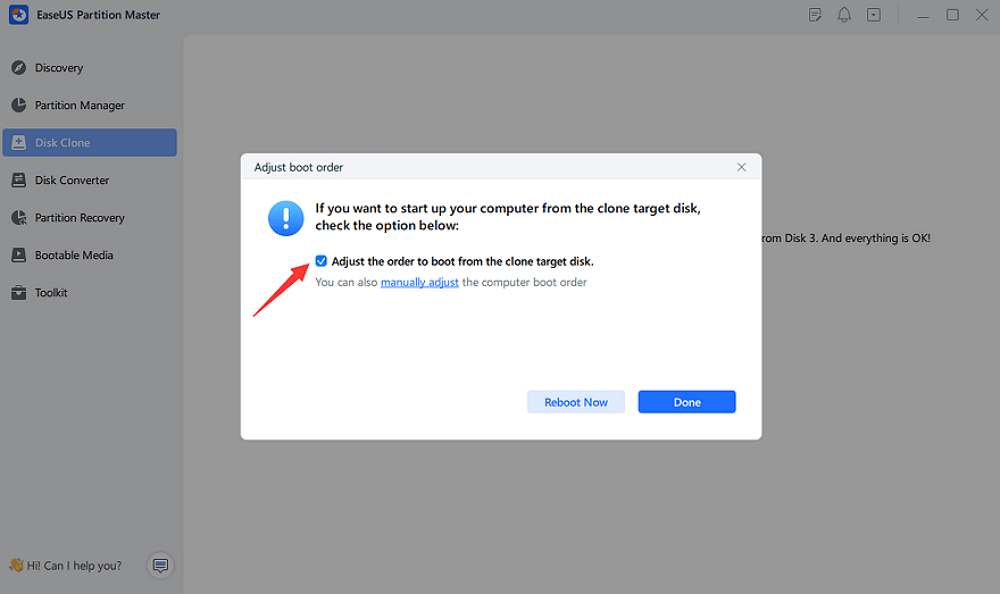
🔖BONUS TIP: If you plan to switch the entire OS and data to another new PC, you can disconnect the newly cloned disk and install it in the new PC. Then, set the new disk as the boot drive on the target computer, and boot it as a fresh new device with your previous system switched from the old PC.
Tutorial to Migrate System with Checklist
Here is a checklist that you can follow to prepare everything for a smooth system migration operation:
- ✔️Prepare a new disk: an equal or bigger storage space than the system drive used space.
- ✔️Install and initialize the disk: initialize the new HDD or SSD to the same type of the OS disk - MBR/MBR, GPT/GPT.
- ✔️End task of all running programs: exit or close all running programs, stop transferring or using any files.
- ✔️Back up vital data: create a backup of important data on the OS disk to another drive if possible.
- ✔️Don't interrupt the operation: once you start the cloning process, don't pause or halt the operation.
- ✔️Install OS migration software: get a reliable OS migration software installed on your PC.
Steps to migrate OS to HDD/SSD:
- Run EaseUS Partition Master, and select "Clone" from the left menu.
- Check "Migrate OS" and click "Next".
- Select the SSD or HDD as the destination disk and click "Next".
- Check Warning: the data and partitions on the target disk will be deleted. Make sure that you've backed up important data in advance. If not, do it now.
- Then click "Yes".
- Preview the layout of your target disk. Then click "Start" to start migrating your OS to a new disk.
- After this, click "Reboot Now" or "Done" to determine if you want to reboot the computer from the new disk immediately.
"Reboot Now" means to keep the changes instantly, while "Done" means you need to restart the computer later manually.

Note: The operation of migrating OS to SSD or HDD will delete and remove existing partitions and data on your target disk when there is not enough unallocated space on the target disk. If you saved important data there, back up them to an external hard drive in advance.
After this, you'll have one last step to take: configure the new disk as the boot drive on your PC. Follow the next part and learn how to fulfill this task effectively. Also, don't forget to share this tutorial online to help more of your friends master this skill and switch their OS to a new drive efficiently.
Change BOOT Drive After System Clone or System Migration [IMPORTANT]
To ensure the system will boot up from your PC, remember to configure the new disk with the cloned or migrated system as the boot drive.
Here are the steps:
- Install the new disk by cloning or migrating OS to the PC.
- Restart your PC and press F2/F8/Del to enter BIOS settings.
- Go to the Boot Menu and set the new disk with the cloned or migrated system as the boot drive.
- Press F10 or click Save and Exit to reboot the PC from the new disk.
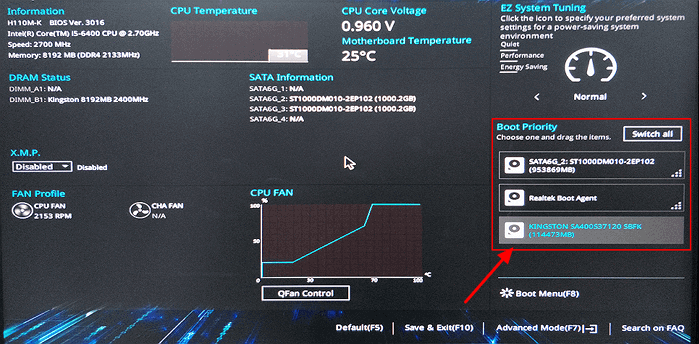
System Clone VS System Migration: When To Use It?
If you are not quite clear about how to choose a process to achieve your desired target. Dive into the scenarios listed below, and you can practically implement these processes. We will also discuss the pros and cons of system cloning and migration in this part.
#1. When to Use System Clone
A system clone creates an exact copy of the OS disk to another one, so let us think of user scenarios where we make copies for practical purposes.
✔️Backup of the existing system: If you are using software or working on a critical system, we can create a copy (backup) in case of failures, system corruption, and data loss.
✔️Identical systems: If your company has multiple branches, and you develop a security mechanism to guard your premises. Rather than creating separate software for each branch, you can clone the system and deploy it in different branches.
✔️Testing purposes: To test software or systems in real time, you can create clones os systems, test them without making changes to the original system in case of any faults or downsides.
✔️Upgrading OS disk or transfer to new PC: To replace the original OS disk to a bigger HDD or a faster SSD, or switch the entire OS with disk data to a new computer.
Pros and Cons of Using System Clone
| Pros👍🏻 | Cons👎🏻 |
|---|---|
|
|
#2. When to Use System Migration
Just like cloning, we need to understand the practical scenarios to adapt the migration processes in our work.
✔️Upgrading to a new disk: If you want to move all your current work and applications onto a compatible HDD or SSD and OS ( for example, an upgraded PC) for better system performance, we can opt for migration.
✔️Transferring selective data: If you want to move only installed apps and files to a new disk, system migration is the best way to do it.
✔️Isolating data from the system: To secure and protect your vital data, you can select to transfer your system and apps to a new disk, keeping the old disk as a data storage disk to secure all your work files and personal documents.
Pros and Cons Of Using System Migration
| Pros👍🏻 | Cons👎🏻 |
|---|---|
|
|
The Final Verdict
As the names suggest, the system clone refers to creating an exact copy of the original system disk with everything to a new disk, while system migration is moving the required data and applications with the operating system to another disk. The method you need to opt for should be based on your purpose, and refer to the uses to get an idea about it.
Once you have decided on the process, you can use the specialized EaseUS Partition Master to complete this in a few clicks. Refer to the guide to complete this tiring process efficiently.
If you find this article helpful, share it with your friends and leave a comment about it.
FAQs About System Clone VS System Migration
Here are some of the most frequent FAQs asked on the topic. If you have similar queries, I hope this will help you.
1. What is the difference between cloning and migration?
The fundamental difference lies in the names; cloning refers to making a copy of something, and migration means moving something. As far as computer systems are concerned, system cloning is a process of making a bit-by-bit copy of an existing system, and system migration is moving or transferring data and applications onto a new system or disk.
2. What is a system clone?
System cloning in computers or PCs refers to creating an exact copy of the existing system for backup or data transfer. Or remake your Computer's Operating system and all its settings, data, and information to get identical systems.
3. What is the difference between a disk clone and a system clone?
System migration vs clone disk, what's the difference? The significant differences lie in the circumstances in which you use these operations. A disk clone or disk image is created if your hard drive is corrupted due to malware, bad sectors, or virus attacks. The system clone is created if you want to sell your device or replace your hard drive to back up all the relevant data, applications, and programs onto a new one.
How Can We Help You
About the Author
Updated by Tracy King
Tracy became a member of the EaseUS content team in 2013. Being a technical writer for over 10 years, she is enthusiastic about sharing tips to assist readers in resolving complex issues in disk management, file transfer, PC & Mac performance optimization, etc., like an expert.
Product Reviews
-
I love that the changes you make with EaseUS Partition Master Free aren't immediately applied to the disks. It makes it way easier to play out what will happen after you've made all the changes. I also think the overall look and feel of EaseUS Partition Master Free makes whatever you're doing with your computer's partitions easy.
Read More -
Partition Master Free can Resize, Move, Merge, Migrate, and Copy disks or partitions; convert to local, change label, defragment, check and explore partition; and much more. A premium upgrade adds free tech support and the ability to resize dynamic volumes.
Read More -
It won't hot image your drives or align them, but since it's coupled with a partition manager, it allows you do perform many tasks at once, instead of just cloning drives. You can move partitions around, resize them, defragment, and more, along with the other tools you'd expect from a cloning tool.
Read More
Related Articles
-
How to Disable Write Protection on Kingston DT50 [Full Guide]
![author icon]() Cici/2025/12/23
Cici/2025/12/23 -
How to Fix Windows Stuck on Diagnosing Your PC -10 Ways👍
![author icon]() Cici/2025/12/23
Cici/2025/12/23 -
How to Reset Forgotten Windows 10 Password with Boot CD 🔥
![author icon]() Sherly/2025/12/23
Sherly/2025/12/23 -
How to Reallocate Disk Space Without Losing Data in Windows 11/10/8/7
![author icon]() Brithny/2025/12/23
Brithny/2025/12/23
Hot Topics
EaseUS Partition Master

Version 20.0 is here - full exFAT support, easier disk partitioning, and PC performance optimization.









